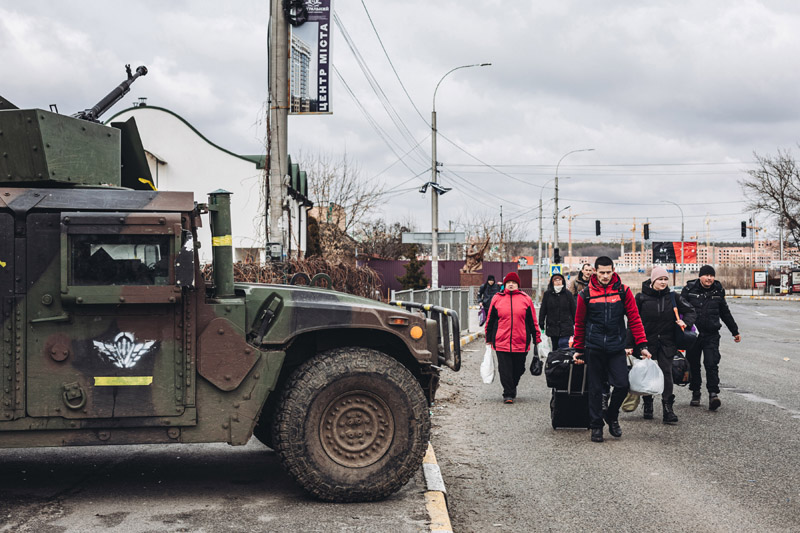India for safe passage to 700 students in Sumy
MOSCOW/KYIV, Mar 5: Russia today declared a ceasefire from 10 am (Moscow time) to allow civilians to leave the cities of Mariupol and Volnovakha. “Humanitarian passages and exit routes have been coordinated with the Ukrainian side,” the Russian Defence Ministry said.
“Starting at 10 am Moscow time today, on March 5, the Russian side declares a ceasefire and opens humanitarian passages for civilians to leave Mariupol and Volnovakha,” it said.
The Ukrainian side confirmed the ceasefire. Mykhailo Podoliak, an adviser to the head of the Ukrainian President’s Office, said that on March 5, starting at 9 am (Ukrainian time), a regime of silence will be announced in Kyiv. He also said that more cities would be added to the list for opening humanitarian corridors.
“Yes, we confirm the information. As for the number of cities, this is just the beginning. A working model is being worked out – after which other cities and villages will be gradually added to the list of places for evacuation,” Podoliak said.
A day earlier, the head of the National Center for Defense Control of the Russian Federation, Colonel-General Mikhail Mizintsev, said that a catastrophic humanitarian situation had developed in most of the territory of Ukraine with a tendency to worsen. According to him, the most difficult situation is observed in Kyiv, Kharkov, Sumy, Chernigov and Mariupol.
The office of Ukrainian President Volodymyr Zelenskyy has stated that Ukraine was ready to ensure the removal and delivery of humanitarian supplies, and that Ukrainian troops would guarantee the safe passage of the corridors.
In addition, Ukraine has asked the International Committee of the Red Cross to urgently assist in the creation of humanitarian corridors. On March 3, the second round of talks between the delegations of Russia and Ukraine took place in Belarus.
As the head of the Russian delegation Vladimir Medinsky said, Moscow and Kiev discussed the military and international humanitarian issues , as well as the future of the political settlement of the situation.
During the negotiations, which lasted more than five hours, an understanding was reached on a number of important issues, including the organization of humanitarian corridors for the civilian population.
The press secretary of the President of Russia Dmitry Peskov emphasized, that the understanding reached on humanitarian issues is extremely important.
Meanwhile, it sounds like a nightmare come true. During a military offensive as part of Russia’s invasion of Ukraine, fire broke out at Europe’s largest nuclear power station, the Zaporizhzhia power plant in the southern city of Enerhodar.
From what we understand of the situation, Russian troops were shelling the area during a battle for control of the facility, which supplies 25% of Ukraine’s electricity.
The plant has six large 950-megawatt reactors, built between 1980 and 1986 – crucially to a different design to the notorious and now decommissioned Chernobyl power station.
The fire evidently broke out in a multi-storey training building but has since been reportedly extinguished.
Was there a real risk of nuclear contamination?
The incident understandably raised the spectre of the 1986 Chernobyl disaster. But it’s important to remember these are two different types of reactor. Chernobyl used RBMK-type reactors, a Soviet design from the 1970s that was never built in the West because of inherent safety flaws.
The Zaporizhzhia power station features Russian-designed VVER reactors, which use broadly the same design as the Pressurised Water Reactor (PWR), the most popular reactor design used worldwide and also the type used in nuclear-powered submarines.
Meanwhile, India today “strongly pressed” the Russian and Ukrainian Governments through multiple channels for an immediate ceasefire in Sumy to ensure a safe passage for around 700 Indian students stuck there as it keeps focus on their evacuation from the war-hit city in eastern Ukraine.
External Affairs Ministry spokesperson Arindam Bagchi said India’s main focus is now on evacuating the students from Sumy, and that the safe exit of Indians from Kharkiv and Pisochyn is almost complete.
Amid growing concerns over the well being of Indian students in Sumy, Prime Minister Narendra Modi called another high-level meeting to discuss the situation in Ukraine and India’s evacuation efforts, official sources said.
“We are deeply concerned about Indian students in Sumy, Ukraine. Have strongly pressed Russian and Ukrainian governments through multiple channels for an immediate ceasefire to create a safe corridor for our students,” Bagchi said.
“Have advised our students to take safety precautions, stay inside shelters and avoid unnecessary risks,” he said on Twitter.
Bagchi also said the main challenge remains the ongoing shelling and violence in Sumy and lack of transportation.
In a message, the Indian envoy to Ukraine Partha Satpathy said no stone will be left unturned for the safe evacuation of Indian students from Sumy city as he hailed the unparalleled strength and fortitude displayed by the young citizens in dealing with the adversities.
Satpathy came out with the message hours after the Indian students in Sumy posted videos saying they have decided to leave for the Russian border and that the Indian government and the embassy in Ukraine will be responsible if anything happens to them.
In the last few days, the students have been sending SOS messages and posting videos on social media, pleading for their urgent evacuation from the conflict zone as the city has been witnessing air strikes.
Following the embassy’s assurance, the students did not leave the eastern Ukrainian city that has seen intense fighting between Russian and Ukrainian troops.
“We are afraid. We have waited a lot and we cannot wait anymore. We are risking our life. We are moving towards the border. If anything happens to us, all the responsibility will be on the Government and Indian embassy,” a student, surrounded by a large number of his peers holding Indian flags, says in one of the videos.
In another video, students are seen filling up buckets with ice as they ran out of drinking water. (Agencies)


